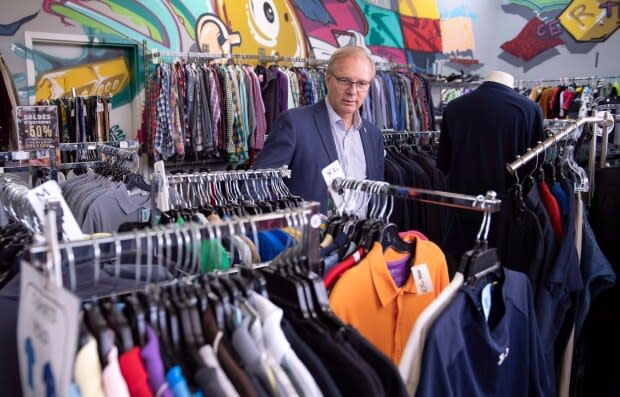'A great way to wear your activism': Apps are powering a fashion resale revolution
In the market for a vintage blazer or second-hand sneakers? There's an app for that.
The proliferation of e-commerce tools has propelled the fast fashion industry, giving anyone with an internet connection the ability to put together a new outfit with just a swipe or a click.
But it's not just new clothes we're buying. In fact, with the help of apps, the digital thrift market is eclipsing traditional retail in growth, as savvy shoppers hunt for bargains, luxury goods, and a more ecologically conscious way to keep their wardrobes up to date.
Buying and selling second-hand goods online certainly isn't a new phenomenon. Almost as long as the internet has existed, there have been platforms for shopping. eBay, founded in 1995, has been around for 25 years, spawning a category of online marketplace akin to a flea market, with competitors like Craigslist and Kijiji, where seemingly anything and everything is for sale.
But according to fashion insiders, this new generation of resale platform is different. These new apps are competing not with the likes of eBay, but with the fast fashion brands that dominate social media feeds, offering the convenience of searching by size or brand, linked to the trendy styling of Instagram.
Business is booming
The approach seems to be working: According to a recent ThredUp report, second-hand retail grew 21 times faster than the traditional retail apparel market in the last three years, and is poised to be worth over $50 billion US within the next five years. Luxury resale startups like The RealReal and Poshmark are valued at well over $1 billion each.
Not surprisingly, traditional retailers are taking note.
Last year, Neiman Marcus invested in the luxury reseller Fashionphile, and Foot Locker invested $100 million US in the shoe reseller Goat. Just last week, Nordstrom launched See You Tomorrow, a resale shop in New York, which they started purely based on customer interest.
The Thred Up report found that nearly nine in 10 retail executives want to get into the growing resale market this year.
Better quality, better prices
According to Amanda Cosco, the founder of Electric Runway, there are several reasons for the explosive growth of the second-hand market.
For starters, she says, older clothes are better quality than most of today's fast fashion. She notes, "Forever 21's collapse indicated that consumers are moving away from cheap thrills like trend pieces and towards choosing more durable, classic pieces that will stand the test of time."

Consumers can also get those quality items for less, says Cosco. "Second-hand is more affordable, especially when it comes to luxury items like handbags. Consumers who can't afford brands like Chanel are just as happy to purchase a gently used Chanel on the second-hand market. It's their way of buying into a brand that was previously inaccessible."
Savvy shoppers now have these options, thanks largely to a growing number of apps and online platforms.
"Scouring the racks at Value Village or your local thrift store requires time to sort through and try on items, as well as a good eye for your desired style. On apps and platforms, you can shop via your mobile phone," says Cosco.
"You can follow people who are your size and who represent the style you're aspiring to, so finding what you love is a lot easier."
Peer-to-peer versus consignment
The new generation of online resale can be sorted into two categories: peer-to-peer and consignment services.
Peer-to-peer platforms are similar to eBay, where sellers create accounts, upload photos and descriptions of goods, and fulfil shipments.
But unlike eBay, Cosco says, new peer-to-peer platforms like Poshmark and Depop operate more like social media in creating communities based on interests and influence. "Where sellers on eBay and Craigslist were fairly anonymous," she says, sellers on these new apps create profiles that showcase their style, and followers are invited to "shop their closet."
With consignment apps like The RealReal, the platform itself is more involved in the resale process, photographing and listing items on behalf of sellers, often in order to ensure the quality of brand name luxury goods. That's especially important when the internet is overflowing with people selling fakes that can sometimes be difficult to distinguish from the real thing.
Brands like The RealReal require all products to be shipped to their warehouses where, once authenticated, they style and photograph the item, explains Andrea Romero, manager of the Fashion Zone at Ryerson University.
"Authentication is a huge thing," says Romero. "On eBay, we have to trust the seller is acting in good faith, whereas sites like Goat and RealReal take care of this for us, so we can feel confident in making a purchase."
A more sustainable wardrobe
But the appeal of resale isn't just about scoring luxury goods, says Romero. As we see the rise in efforts toward sustainability, resale is also an attractive option for consumers who want to make more ecologically conscious decisions.
According to the United Nations, greenhouse gas emissions from textiles production, at 1.2 billion tonnes annually, exceed those of all international flights and maritime shipping combined. Buying an item used reduces its carbon footprint by approximately 82 per cent.
"Buying second-hand is a great way to wear your activism by extending the life of a garment and keeping it out of landfills," says Cosco.
Romero adds, "The fact that we can do this from the comfort of our own home — that's a game changer."

